
How psychology works the facts visually explained (DK) (Z-Library)
.pdf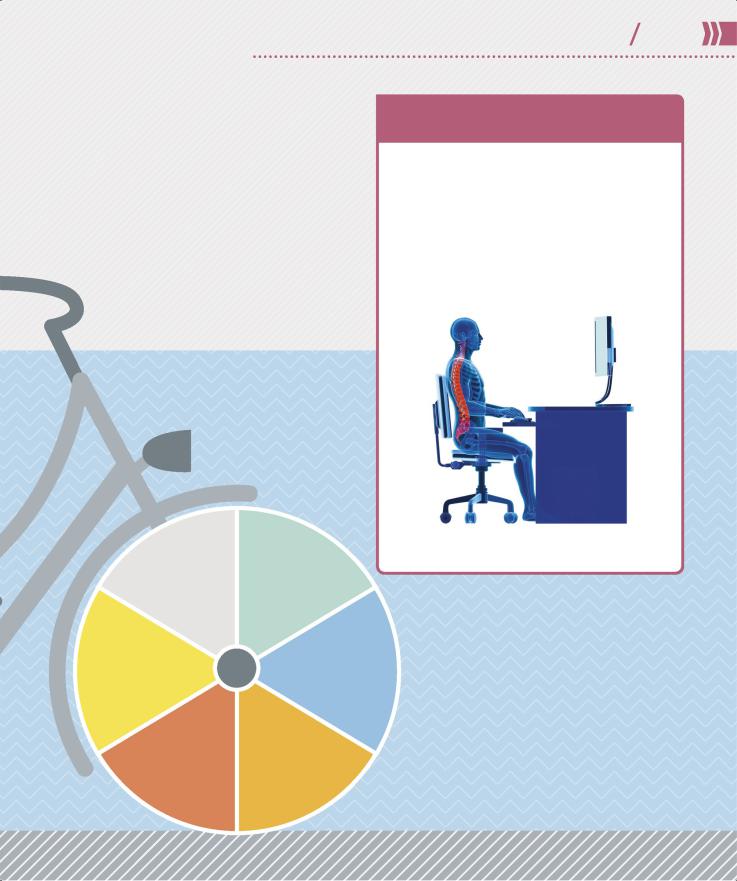
70%
or more of aircraft accidents are due to human error
PSYCHOLOGY IN THE REAL WORLD |
188 189 |
HFE psychology |
MEASUREMENTS AND
PRODUCT DESIGN
Two important fields within HFE are anthropometry— the science of measuring the human body and its proportions—and ergonomics—engineering products to fit the human body. Both are essential in creating user-friendly technology. Products such as office chairs designed with a full set of measurements, taking proportions into account, promote worker efficiency and protect from shortand long-term physical harm. Measurements include both obvious ones, such as eye height when sitting, and proportional distances, for instance, between the sitter’s buttocks and toes.
|
|
|
|
|
|
|
|
|
|
|
S |
|
|
|
|
|
|
|
|
|
|
|
R |
|
|
|
|
|
|
|
|
|
|
O |
|
|
|
|
|
|
|
|
|
|
T |
DECISION-MAKING |
|
|
|
|
|
|
|
|
|
C |
|
||
|
|
|
|
|
|
L |
F |
A |
|
|
Addressing each step in |
|
|
|
|
|
A |
|
|
|
|||
|
|
|
|
|
|
|
|
|
|||
|
|
|
|
C |
|
|
|
|
the decision-making |
||
|
|
G |
I |
|
|
|
|
|
|||
|
|
|
|
|
|
|
|
||||
|
|
|
|
|
|
|
|
process to fix operator |
|||
|
O |
|
|
|
|
|
|
|
|||
|
|
|
|
|
|
|
|
|
|||
|
|
|
|
|
|
|
|
|
|
glitches |
|
L |
|
|
|
|
|
|
|
|
|
||
O |
|
|
|
|
|
|
|
|
|
|
|
H |
|
|
|
|
|
|
|
|
|
|
|
C |
|
|
|
|
|
|
|
|
|
|
|
Y |
|
|
|
|
|
|
|
|
|
|
|
S |
|
|
|
|
|
|
|
|
|
|
SITUATION |
P |
|
|
|
|
|
|
|
|
|
|
|
AWARENESS
Training staff to assess work situations objectively
HUMAN ERROR
AND SAFETY
Analyzing the causes of mistakes and making changes to improve safety
ERGONOMIC SEATING takes into account the sitter’s elbow STRESS AND height, seat height, thigh clearance, eye level, and back support.
ANXIETY
Using well-designed equipment to avoid workers’ frustration
WORKLOAD
Balancing employees’ workload so that they are alert, are focused, and exercise good judgment
TEAMWORK
Fostering work relations to ensure team members cooperate
Two-way process
HFE psychologists apply a scientific approach to understanding how humans behave in their interactions with technology. This is a two-way process—people’s efficiency can be undermined by poorly designed equipment, and flaws in
people’s behavior undermine the efficiency of the technology they use. To confront these issues and predict future performance, psychologists study how individuals perceive stimuli and events, assess these to determine a course of action, and make an appropriate response.
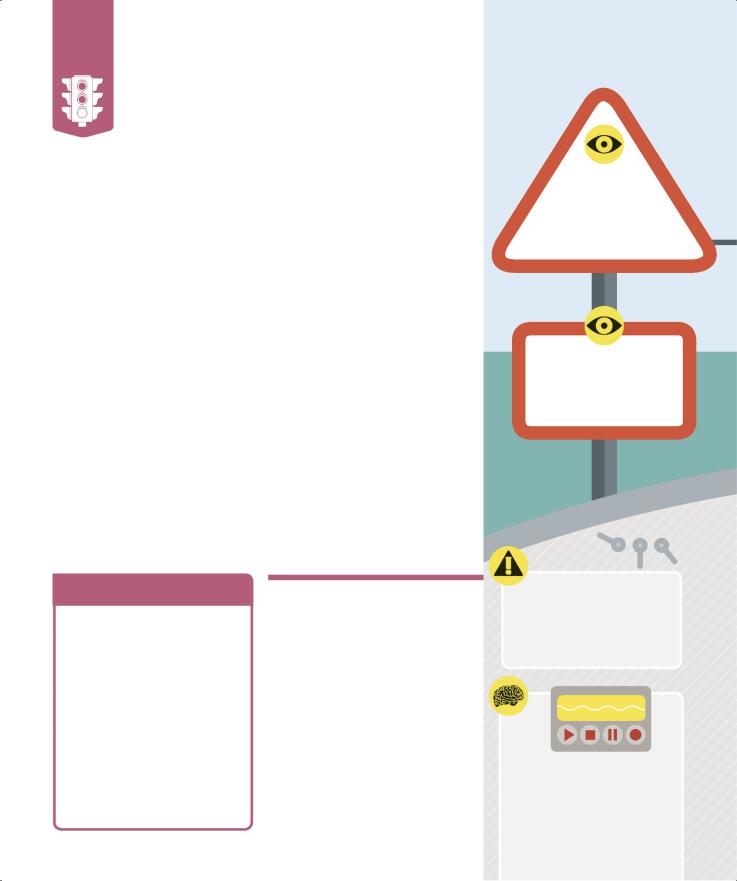
Engineering displays
Drawing on their understanding of how people’s minds process information, psychologists work with product designers to engineer better machines.
User-friendly technology
A key role of HFE psychologists is designing machines, signs, and systems that can be operated more effectively by their human users. Three interlinked considerations are vital in technology design: how easy the displays are to see and understand; how easy the controls are to use; and how to reduce or eliminate room for error.
Displays are a prime component of technology because they are the interface between machines and their human users. People receive the information they need to operate any particular machine, and also get feedback, via dials, lights, or screens. This applies to a vast array of technological products and systems, including
industrial and office equipment, traffic signs, aviation controls, and medical devices.
Display perception
Psychologists provide valuable input during the design process, using their in-depth knowledge of exactly how the mind sees and interprets color, outlines,
background and foreground, sound, and touch. The aim is to achieve
a “natural design” that makes use of perceptual cues instantly recognizable by the human brain, without the need for further explanation. Using the color red to indicate “stop” is a classic example, since humans associate it with danger because it is the color of fire and blood.
ALERTING DISPLAYS
Within display design,psychologists have developed a hierarchy of color and sound combinations to convey clear priorities to users. These are based on research into how the eyes, ears, and brain respond to specific cues. They are also based on the knowledge that people pay more attention to messages communicated via more than one sense. For warnings, red is used alongside an audible alert, whereas advisory messages may be signaled with only a visual cue.
Organizing controls
Well-engineered displays take into account the way in which people see, hear, and touch stimuli and process them as information. These stimuli—lights, colors, contrast, sound, touch, and so on—should be arranged to ensure that the brain can react quickly and respond accurately. Four principles govern display engineering: perception, mental mode, attention, and memory.
ABILITY TO
DISCRIMINATE
Signals should be very different from one another to avoid confusion. Warning signs, for instance, normally appear in a triangle.
AVOIDING ABSOLUTE
JUDGMENT LIMITS
Several sensory dimensions— such as pitch, volume, or color—should be offered to aid the user’s judgment.
MINIMIZING INFORMATION
ACCESS COST
Information that is accessed most often should be at hand so that the user does not have to spend too much time finding it.
MOVING PARTS
Any parts that move should synchronize with the user’s expectation—a forward button, for instance, should move in the same direction as the moving part.
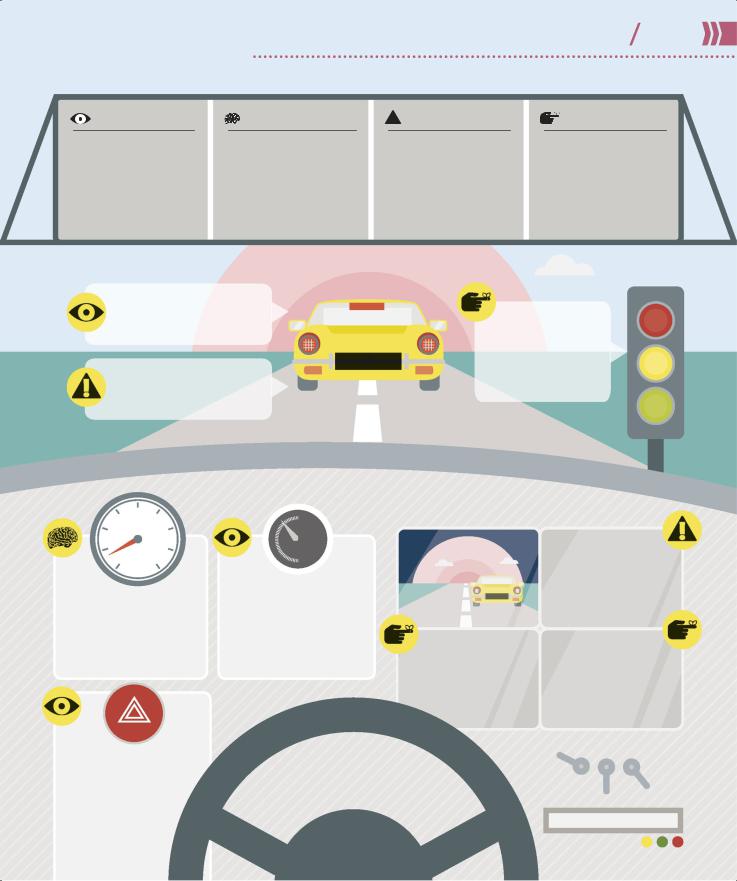
PSYCHOLOGY IN THE REAL WORLD |
190 191 |
HFE psychology |
Perception |
Mental model |
! Attention |
Memory |
How users first perceive the information in front of them—it must be presented in an unambiguous way.
How the design aligns with the mental model of its user—people usually interpret a display based on their experience of similar systems.
How accessible and easy to process the information is, even in a distracting environment.
How it reinforces a user’s preexisting memory, acting as an aid to recall rather than forcing the user to store information within reach in their working memory.
REDUNDANCY GAIN
Presenting a message in more than one way (such as an extra brake light) enhances its impact.
PROXIMITY COMPATIBILITY
Relevant or linked information, like three brake lights, should be displayed close together.
CONSISTENCY
Information should be presented consistently to ensure a user knows how to interpret it—for example, on traffic lights, red always means “stop.”
PICTORIAL REALISM
A display should convey information graphically—for example, if the level of fuel has gone down, the fuel gauge should also go down.
TOP-DOWN PROCESSING
The expectations of the user based on past experience
should be met—for example, a user expects to press a button to turn something on.
LEGIBLE DISPLAY
Dials and backlit information must be clear, with contrasting colors and a large enough font size for the information
to be read easily.
KNOWLEDGE OF
THE WORLD
Showing information means the user does not
have to rely as much on memory.
MULTIPLE RESOURCES
Information should be delivered through more than one medium—satellite navigation systems use a voice as well as a screen.
PREDICTIVE AIDING
Users should be helped to predict a course of movement, such as where a traffic jam is expected to be, so they can be proactive.

Human error and prevention
The most important aspect of HFE psychology is minimizing the role of human error to improve safety in the workplace and reduce the risk of accidents and fatalities.
What is it?
Eliminating human error may be an impossible goal, but HFE psychology is dedicated to reducing it as much as possible through strategic changes to the design of workplace machines and displays
and the way in which people handle information. Error reduction is especially relevant for situations in which the risk of death is high, such as road-traffic control centers, nuclear power facilities, hospitals, airplane flights, and war zones.
What went wrong?
Most accidents in these industries result from human error. In commercial aviation, for example, failure to load the aircraft correctly, air traffic control mistakes, and errors pilots make in operating the
Inadvertent error
Skill-based error (action error)
Trained worker who loses concentration or is distracted making an unintentional error during a routine task carried out perfectly many times before
Mistake
Worker inadequately trained for the situation making a poor decision: doing the wrong thing while believing it to be right
Slip of action |
Memory lapse |
Executes steps in the wrong order |
Forgets to do something |
Mistimes an action |
Skips an important step |
Transposes digits—0.56, not 0.65 |
Repeats a step |
Presses the wrong button |
Fails to switch off a machine |
Turns a control the wrong way |
Gets distracted; loses their place |
Control measures |
|
Rule-based mistake
Uses the wrong set of rules
Ignores a genuine alarm after numerous false ones
Fails to initiate a rule in timeApplies a poorly conceived rule
Improve the design of equipment to reduce skill-based errorsAnalyze error incidents and update work conditions accordingly
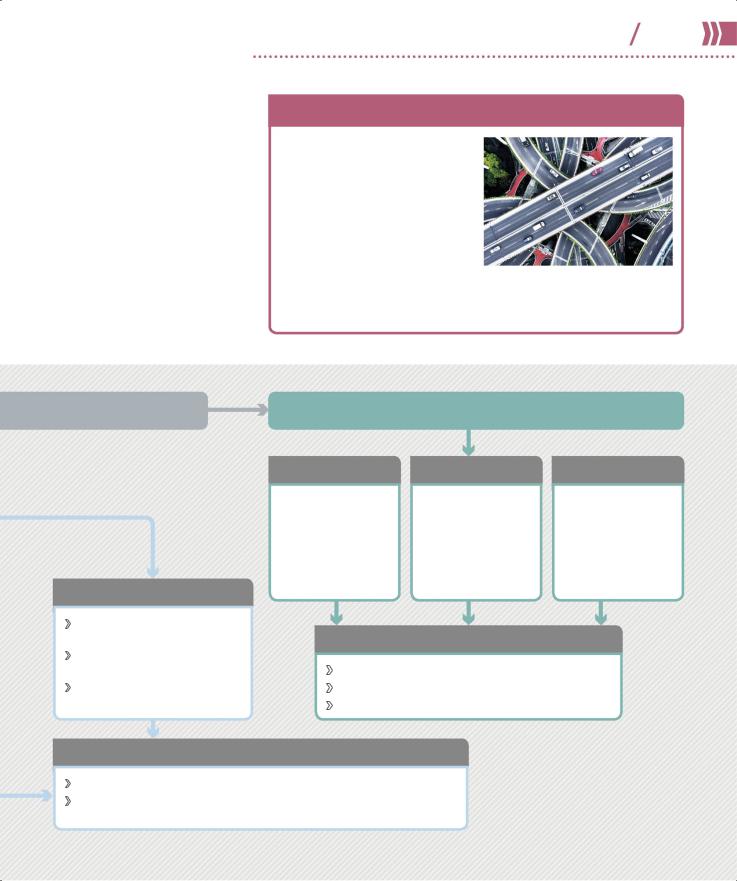
PSYCHOLOGY IN THE REAL WORLD |
192 193 |
HFE psychology |
airplane’s controls or assessing weather conditions are the most likely causes of accidents.
In studying past errors and the sequence of human action leading up to them, psychologists have concluded that wrong decisionmaking is usually because of a lack of situation awareness. Therefore, a primary aim of HFE psychologists is to enhance such awareness. This includes a person’s ability to perceive his or her environment accurately, comprehend what is happening, and predict an outcome.
TRAFFIC PSYCHOLOGY
Some HFE psychologists specialize in the study of how drivers behave on the road and respond to traffic management. The areas this covers include behavior and accident research, which looks at age and personality as accident risk factors; traffic enforcement strategies; and driver rehabilitation programs. Studying the role played by stress, tiredness, phone use, alcohol, and other factors helps psychologists understand what causes accidents.
TRAFFIC SAFETY TRAINING and education helps to keep people safe on the roads.
HUMAN ERROR
Knowledge-based mistake
Lacks the knowledge to deal with the task
Develops a solution that does not work
Applies trial and error to a task
Deliberate noncompliant violation
Routine |
Situational |
Commonplace rule |
Rule breaking due to |
breaking, such as |
time pressure, poor |
using the fire escape |
equipment, or work- |
stairs instead of the |
place design, such as |
elevator between |
using untrained staff |
office levels |
to help meet an |
|
urgent deadline |
Exceptional
Rule breaking with little choice in a rare situation, such as a bus driver letting off a frail passenger between stops when paths are icy
Preventing violations
Ensure rules are relevant; explain reasons behind themOffer adequate supervision and training for emergenciesEncourage open communication
Control measures
Train staff to be prepared for nonroutine, high-risk tasks
Supervise inexperienced staff and provide them with diagrams to explain procedures

Forensic psychology
This rapidly expanding field concerns the application of psychology within a legal context. Its primary goals are the collection, examination, and presentation of evidence for judicial purposes, and the treatment and rehabilitation of criminals once they have entered the prison system. Psychologists are becoming increasingly influential in court proceedings across the world, bringing
their expertise to a wide range of criminal, family, and civil cases.
IN THE POLICE FORCE
Real-world contributions from forensic psychologists who help track down criminals are less dramatic than they appear on TV, but they have helped open the door to a kind of investigative psychology that serves many aspects of the criminal investigation process.
Selecting police candidates
Psychologists perform evaluations of prospective police officers to see if they have the qualities needed for the job. They use psychological tests and interviews and can offer recommendations.
Managing information systems
They help to establish effective systems for collecting, organizing, and making sense of the vast quantities of information and paperwork associated with
a criminal case.
Conducting interviews
They use their expert knowledge of the human mind and patterns of behavior to refine interview processes. They can detect when people are lying or hiding the truth by analyzing and interpreting words, facial expressions, intonation, and body language.
Linking crimes to suspects
Their analysis of police evidence can be used to identify patterns that link offenses to culprits.
INTHE |
COURTROOMinvaluable |
|
|
|||||||||||||||||||||||||||||||||||||||
|
|
|
|
|
|
|
|
|
|
|
|
|
|
|
can be an |
|
|
|
|
|
legal |
|
|
|||||||||||||||||||
Forensic |
psychologists |
|
|
|
|
|
|
|
|
|
assist |
|
|
|||||||||||||||||||||||||||||
|
|
|
|
|
|
|
|
|
|
|
|
|
|
|
|
. They can |
|
|
|
both |
|
|
|
|
|
|
||||||||||||||||
help in the |
courtroom |
|
|
of ways in |
|
|
|
|
|
|
||||||||||||||||||||||||||||||||
|
|
|
in a number |
|
|
|
|
|
|
|
|
|
|
|
|
|||||||||||||||||||||||||||
proceedings |
|
|
|
|
|
|
|
|
|
|
|
|
|
|
|
|
|
|
|
|
|
|
||||||||||||||||||||
|
|
|
|
|
|
|
|
|
|
|
|
. |
|
|
|
|
|
|
|
|
|
|
|
|
|
|
|
|
|
|
|
|
|
|
||||||||
criminal |
and civil courts |
|
|
|
|
|
|
|
|
|
|
|
|
|
|
|
|
|
|
|
|
|
|
|||||||||||||||||||
expert |
testimony |
|
|
|
|
|
|
|
|
|
|
|
|
|
|
|
|
|
||||||||||||||||||||||||
Giving |
|
|
|
|
the |
facts |
|
|
||||||||||||||||||||||||||||||||||
|
|
|
|
|
|
|
|
|
|
|
not just |
|
|
|||||||||||||||||||||||||||||
|
|
|
|
|
|
|
|
can present |
|
|
||||||||||||||||||||||||||||||||
|
|
|
|
|
|
|
|
|
|
|
|
|
|
|
|
|||||||||||||||||||||||||||
|
|
|
|
|
|
|
|
|
|
|
specialized |
|
||||||||||||||||||||||||||||||
Psychologists |
|
|
their |
|
||||||||||||||||||||||||||||||||||||||
|
|
|
|
|
|
|
but also |
|
||||||||||||||||||||||||||||||||||
|
|
|
|
|
|
|
|
|
|
|
|
|
|
|
|
|
|
. |
|
|||||||||||||||||||||||
of the case |
in court, |
|
|
|
|
|
|
|
|
|
of those |
|
facts |
. |
||||||||||||||||||||||||||||
opinions |
and interpretations |
|
|
|
|
|
|
the verdict |
||||||||||||||||||||||||||||||||||
|
|
|
|
|
|
|
can greatly |
influence |
|
|
|
|
|
|
|
|
|
|
||||||||||||||||||||||||
Such |
opinions |
|
|
|
|
|
|
|
|
|
|
|
|
|
|
|
|
|
|
|||||||||||||||||||||||
|
|
|
|
|
|
|
|
|
|
for lawyers |
|
|
|
|
|
|
||||||||||||||||||||||||||
|
|
|
|
|
|
|
|
|
guidance |
|
|
|
|
|
|
|||||||||||||||||||||||||||
Providing |
|
|
of |
|
|
|||||||||||||||||||||||||||||||||||||
|
|
|
at every |
stage |
|
|
||||||||||||||||||||||||||||||||||||
|
|
|
|
|
|
|
lawyers |
|
|
|||||||||||||||||||||||||||||||||
|
|
|
|
|
|
|
|
|
to |
|
||||||||||||||||||||||||||||||||
|
|
can advise |
|
them |
|
|||||||||||||||||||||||||||||||||||||
They |
|
|
|
|
from helping |
|
|
|
||||||||||||||||||||||||||||||||||
|
|
|
|
|
|
|
|
process, |
|
|
|
about |
|
|||||||||||||||||||||||||||||
the judicial |
|
|
|
|
|
to advising |
|
|||||||||||||||||||||||||||||||||||
|
|
|
|
|
for court |
|
|
|
|
for |
|
|||||||||||||||||||||||||||||||
|
|
|
|
|
|
|
a case |
|
|
|
|
|
|
|
|
|
|
|
|
|
|
|
||||||||||||||||||||
prepare |
|
|
|
|
|
|
|
|
|
of questioning |
|
|
|
|
||||||||||||||||||||||||||||
|
|
|
|
|
|
|
and lines |
|
|
|
|
|||||||||||||||||||||||||||||||
jury selection |
|
|
. |
|
|
|
|
|
|
|
|
|
|
|
|
|
|
|
|
|||||||||||||||||||||||
|
|
|
|
|
|
|
|
|
|
|
|
|
|
|
|
|
|
|
|
|
|
|
|
|
|
|
|
|||||||||||||||
witnesses |
and defendants |
|
|
|
|
and |
jury |
|
||||||||||||||||||||||||||||||||||
|
|
opinions |
to judge |
|
||||||||||||||||||||||||||||||||||||||
|
|
|
|
|
|
|
|
|||||||||||||||||||||||||||||||||||
Offering |
|
|
|
educated |
|
|||||||||||||||||||||||||||||||||||||
|
|
|
|
|
|
|
make |
|
||||||||||||||||||||||||||||||||||
judges |
and juries |
|
||||||||||||||||||||||||||||||||||||||||
They help |
opinions |
|
||||||||||||||||||||||||||||||||||||||||
|
|
|
|
|
|
|||||||||||||||||||||||||||||||||||||
|
|
|
|
their expert |
|
|||||||||||||||||||||||||||||||||||||
by offering |
|
|
|
|
|
|
|
|
|
|||||||||||||||||||||||||||||||||
decisions |
|
|
|
and by interpreting |
||||||||||||||||||||||||||||||||||||||
|
|
|
|
|
|
behavior, |
||||||||||||||||||||||||||||||||||||
about |
human |
|
|
|
|
|
|
|
|
|
|
the |
|
|
||||||||||||||||||||||||||||
|
|
|
|
|
|
|
|
throughout |
|
|
||||||||||||||||||||||||||||||||
|
|
|
|
|
|
|
behavior |
|
|
|
|
|
|
|
|
|||||||||||||||||||||||||||
defendants’ |
|
|
|
|
|
|
|
|
|
|
|
|
|
|
|
|
|
|
|
|||||||||||||||||||||||
|
|
|
|
|
|
. |
|
|
|
|
|
|
|
|
|
|
|
|
|
|
|
|
|
|
|
|
|
|
||||||||||||||
legal |
proceedings |
|
|
|
|
|
|
|
|
|
|
|
|
|
|
|
|
|
|
|
|
|
|
|||||||||||||||||||
|
|
|
|
|
|
|
|
|
|
|
|
|
|
|
|
|
|
|
|
|
|
|
|
|
|
|
|
|
|
|
|
|
|
|
|
|
||||||

PSYCHOLOGY IN THE REAL WORLD |
194 195 |
Forensic psychology |
|
|
|
|
|
|
|
|
|
|
|
|
|
|
|
|
|
|
|
|
|
|
|
|
|
|
|
|
|
|
|
|
|
|
|
|
|
|
|
|
|
|
offenders |
are |
|
|
|
|
|
|
||||||||||||||
|
|
|
|
|
|
|
|
|
|
|
|
|
|
|
|
|
|
|
|
SYSTEM |
|
|
inwhich |
|
|
|
|
|
|
|
|
|
|||||||||||||||||||||||||||||||
|
|
|
|
|
|
|
|
|
|
|
|
|
|
|
|
|
|
|
|
|
|
|
|
|
|
|
unnatural |
|
|
|
|
|
|||||||||||||||||||||||||||||||
|
|
|
|
|
|
|
|
|
|
|
|
|
|
|
|
|
|
|
|
|
|
|
|
|
|
|
|
and |
|
|
|
|
|
|
|
|
|
|
|
|
|
|
|
|
|
||||||||||||||||||
|
|
|
|
|
|
|
|
|
|
|
|
|
|
|
|
|
|
|
|
|
|
|
|
|
|
|
facilities |
|
|
|
|
|
|
|
|
|
|
|
psychologists |
|
|
|
|||||||||||||||||||||
|
|
|
|
|
PRISON |
|
|
|
|
|
|
|
|
|
|
|
|
|
areharsh |
|
|
|
|
|
|
|
|
||||||||||||||||||||||||||||||||||||
THE |
|
|
|
|
|
|
|
|
they |
|
|
|
|
|
tothe |
|
|
|
|
|
|
|
|
|
and |
|
|
|
|
||||||||||||||||||||||||||||||||||
|
|
|
|
|
|
|
|
|
correctional |
|
|
|
|
|
|
|
|
|
|
|
|
|
|
|
|
|
|
|
|||||||||||||||||||||||||||||||||||
|
|
|
|
|
|
|
|
|
|
|
|
|
|
|
|
|
|
|
reality |
|
|
|
|
|
|
|
|
|
|
|
|
|
|
|
|
|
|
|
|
|
|
|
|
|
|
|
|
|
|
|
|
|
|
|
|||||||||
IN |
|
|
are |
ideally |
|
|
|
|
|
|
|
in |
|
challenges |
|
|
|
|
|
offenders |
|
|
|
|
|
|
|
|
|||||||||||||||||||||||||||||||||||
Prisons |
|
|
.However, |
|
|
|
|
|
many |
|
|
|
|
|
|
|
|
|
|
|
|
|
. |
|
|
|
|
|
|
|
|
|
|
||||||||||||||||||||||||||||||
|
|
|
|
|
|
|
|
|
|
|
|
|
|
rehabilitate |
|
|
|
|
|
|
|
|
|
|
|
|
|
|
|
|
|
|
|||||||||||||||||||||||||||||||
rehabilitated |
|
|
that |
present |
|
tohelp |
|
files |
and |
reports |
|
|
|
|
|
|
|
|
|
|
|||||||||||||||||||||||||||||||||||||||||||
|
|
|
|
|
|
roleis |
|
of |
case |
|
|
|
|
|
|
|
|
|
|
|
|
|
|
|
|
|
|
|
|
|
|
|
|
|
|
||||||||||||||||||||||||||||
environmentsthere |
|
|
|
|
|
|
|
|
|
|
|
|
|
|
|
|
|
|
|
|
|
|
|
|
|
|
|
|
|
|
|
|
|
|
|
|
|
|
life |
|
|
|
|||||||||||||||||||||
|
|
|
|
|
|
|
|
|
|
|
|
|
.Their |
|
|
|
|
|
|
|
|
|
|
|
|
|
|
|
|
|
|
|
|
|
|
|
|
|
|
|
|
|
|
|
|
|
|
|
|
|
|
||||||||||||
who |
work |
inthe |
preparation |
|
|
|
|
|
|
|
|
|
|
|
|
ofan |
offender’s |
|
|
|
|
||||||||||||||||||||||||||||||||||||||||||
|
|
staff |
|
|
|
|
|
|
|
|
|
|
|
|
|
|
|
|
|
|
|
|
|
|
|
|
|
|
|
their |
relapsing |
|
|
||||||||||||||||||||||||||||||
to |
aid |
|
|
|
|
|
|
|
|
|
offenders |
|
|
|
|
|
|
|
aspects |
|
|
|
risk |
of |
|
|
|
|
|
and |
|
||||||||||||||||||||||||||||||||
|
|
|
|
|
with |
which |
|
|
|
|
|
|
sessions |
|
|
|
|||||||||||||||||||||||||||||||||||||||||||||||
|
|
|
|
|
|
|
|
|
|
|
|
|
|
|
|
|
|
|
|
|
|
|
the |
|
|
|
|
|
|
|
the |
|
|||||||||||||||||||||||||||||||
|
|
|
|
|
|
|
|
|
|
|
|
|
|
|
|
|
|
|
|
|
|
|
|
|
|
|
therapy |
|
|
|
|
|
|
||||||||||||||||||||||||||||||
Working |
|
|
|
|
|
|
|
|
|
|
to |
identify |
|
|
to |
reduce |
|
|
|
|
|
|
|
|
|
|
|
|
|
||||||||||||||||||||||||||||||||||
|
|
|
|
|
|
|
|
|
|
|
|
|
|
|
|
|
|
|
|
|
|
|
|
|
|
|
|||||||||||||||||||||||||||||||||||||
|
|
|
|
aim |
|
|
|
|
|
|
|
|
|
|
|
|
|
ofgroup |
|
|
|
|
|
|
|
|
mitigating |
|
|
|
|||||||||||||||||||||||||||||||||
|
|
|
|
|
|
|
|
|
|
|
|
|
|
|
|
|
|
|
|
|
|
|
|
|
|
|
|
|
|
|
|
|
|
|
|
|
|||||||||||||||||||||||||||
|
|
|
|
|
|
|
|
|
|
|
|
|
|
|
|
treatment |
|
|
|
|
|
|
|
|
|
|
|
|
|
|
|
|
|||||||||||||||||||||||||||||||
|
|
|
|
|
|
|
|
|
|
|
|
|
|
|
|
|
|
|
of |
|
|
|
|
|
|
|
|
|
|
|
|
involve |
|
|
are |
often |
|
|
|||||||||||||||||||||||||
Psychologistsneed |
|
|
|
|
|
|
a |
mixture |
|
|
|
|
|
|
|
|
|
|
|
|
|
|
|
|
|
|
|
|
|
|
|||||||||||||||||||||||||||||||||
|
|
|
|
|
|
|
|
|
|
|
|
|
|
|
canalso |
|
|
traumas |
|
|
distrust |
|
|||||||||||||||||||||||||||||||||||||||||
aremost |
in |
.They |
provide |
|
|
|
|
|
|
|
|
|
|
|
|
|
|
|
|
|
|
|
|
||||||||||||||||||||||||||||||||||||||||
|
|
|
|
|
|
|
|
|
.Treatmentchildhood |
|
|
|
|
rife,and |
|
|
|
|
|
||||||||||||||||||||||||||||||||||||||||||||
|
inthe |
future |
|
counseling |
|
|
|
|
where |
|
|
|
|
|
|
|
|
are |
|
|
|
|
|
|
|
|
|
|
|
|
|
||||||||||||||||||||||||||||||||
|
|
|
|
|
|
|
|
|
|
|
|
|
|
|
|
|
|
|
|
|
|
|
|
. |
|
|
|
|
|
|
|
|
|
|
|
|
|
||||||||||||||||||||||||||
|
|
|
|
-on |
|
|
|
|
|
|
|
|
|
|
|
|
|
in |
prison, |
|
dehumanized |
|
|
|
|
|
|
|
|
|
|
|
|
|
|
|
|
||||||||||||||||||||||||||
|
|
|
|
|
|
|
|
-one |
|
|
|
|
|
|
|
|
|
|
|
|
|
|
|
|
|
|
|
|
|
|
|
|
|
|
|
|
|
|
|
|
|
|
|
|
|
|
|
|
|||||||||||||||
|
one |
|
|
|
|
|
|
|
ofbeing |
|
|
|
ofbeing |
|
|
|
|
|
toviolence |
|
|
|
|
|
|
|
|
|
|
|
|
|
|
||||||||||||||||||||||||||||||
|
|
illeffects |
|
|
|
|
feelings |
|
|
|
|
|
leads |
|
|
|
|
|
|
|
|
|
|
|
|
|
|
|
|
|
|
|
|
|
|
|
progress, |
||||||||||||||||||||||||||
|
|
reactivated, |
|
|
|
|
|
|
|
frequently |
|
|
|
|
|
|
|
|
|
|
|
|
|
of |
their |
patients’ |
|
|
|
||||||||||||||||||||||||||||||||||
|
|
|
|
|
|
|
|
|
|
|
|
|
|
|
|
|
|
|
|
|
|
|
|
|
|
|
|
|
|
|
|
|
assessment |
|
|||||||||||||||||||||||||||||
|
|
|
among |
prisoners |
staff |
|
|
|
|
|
|
|
|
|
|
|
|
|
|
|
|
|
|
|
|
Their |
|
||||||||||||||||||||||||||||||||||||
|
|
|
|
|
|
|
|
with |
|
|
|
|
|
|
|
|
informed . |
|
|
|
|
|
|
|
|||||||||||||||||||||||||||||||||||||||
|
|
|
|
|
|
|
|
|
|
|
|
|
|
|
|
|
|
|
|
authorities |
|
|
|
|
boards |
|
|
|
|
|
|
|
|
|
|
|
|
||||||||||||||||||||||||||
|
|
|
|
|
|
|
|
|
|
|
|
|
|
|
|
|
|
|
|
|
|
|
|
|
|
|
|
|
|
|
|
|
|
|
|
|
|
|
|
|
|
|
|||||||||||||||||||||
|
|
|
|
Working |
|
|
|
|
|
prison |
|
|
|
|
|
with |
parole |
|
|
|
|
|
|
|
|
|
|
. |
|
|
|
|
|
|
|
|
|
|
|
||||||||||||||||||||||||
|
|
|
|
|
|
the |
|
|
|
|
|
|
|
|
isgranted |
|
|
|
|
|
|
|
|
|
|
|
|
||||||||||||||||||||||||||||||||||||
|
|
|
|
|
|
|
|
|
|
keep |
|
|
|
|
|
directly |
|
parole |
|
|
|
|
|
|
|
|
|
|
|
|
|||||||||||||||||||||||||||||||||
|
|
|
|
|
|
|
|
|
|
|
|
|
|
|
|
|
|
|
|
|
|
|
|
|
|
|
|
|
|
|
|
|
|
|
|
|
|
|
|
|
|
|
|
||||||||||||||||||||
|
|
|
|
They |
|
|
|
|
|
|
|
|
|
|
|
|
|
|
|
|
|
|
|
|
|
|
|
|
|
|
|
|
|
|
|
|
|
|
|
|
|
|
|
|
|
|
|
|
|
|
|
||||||||||||
|
|
|
|
|
and |
communicateinwhether |
|
|
|
|
|
|
|
|
|
|
|
|
|
|
|
|
|
|
|
|
|
|
|
|
|
|
|
|
|
|
|||||||||||||||||||||||||||
|
|
|
|
|
|
|
|
avital |
role |
|
|
|
|
|
|
|
|
|
|
|
|
|
|
|
|
|
|
|
|
|
|
|
|
|
|
|
|
|
|
|
|
|
|
|
|
|
|
|
|||||||||||||||
|
|
|
|
|
plays |
|
|
|
|
|
|
|
|
|
|
|
|
|
|
|
|
|
|
|
|
|
|
|
|
|
|
|
|
|
|
|
|
|
|
|
|
|
|
|
|
|
|
|
|
||||||||||||||
|
|
|
|
|
|
|
|
|
|
|
|
|
|
|
|
|
|
|
|
|
|
|
|
|
|
The first |
|
|
|
|
|
|
|
|
|
|
|
|
|
|
|
|
|
|
|
||||||||||||||||||
|
|
|
|
|
|
|
|
|
|
|
|
|
|
|
|
|
|
|
|
|
|
|
|
|
|
|
|
|
|
|
|
|
|
“expert” witness |
|
||||||||||||||||||||||||||||
|
|
|
|
|
|
|
|
|
|
|
|
|
|
|
|
|
|
|
|
|
|
|
|
|
|
|
|
|
|
|
|
|
|
In 1896, |
|
|
|
|
|
|
|||||||||||||||||||||||
|
|
|
|
|
|
|
|
|
|
|
|
|
|
|
|
|
|
|
|
|
|
|
|
|
|
|
|
|
|
|
|
|
|
German psychologist |
Albert |
||||||||||||||||||||||||||||
|
|
|
|
|
|
|
|
|
|
|
|
|
|
|
|
|
|
|
|
|
|
|
|
|
|
|
|
|
|
|
|
|
|
|
|
|
|
|
|
||||||||||||||||||||||||
|
|
|
|
|
|
|
|
|
|
|
|
|
|
|
|
|
|
|
|
|
|
|
|
|
|
|
|
|
|
|
|
|
|
von Schrenck- |
|
|
|
|
|
|
|
|
|
|
|
|
|||||||||||||||||
|
|
|
|
|
|
|
|
|
|
|
|
|
|
|
|
|
|
|
|
|
|
|
|
|
|
|
|
|
|
|
|
|
recorded |
|
|
|
|
|
|
|
|
Notzing |
became the first |
||||||||||||||||||||
|
|
|
|
|
|
|
|
|
|
|
|
|
|
|
|
|
|
|
|
|
|
|
|
|
|
|
|
|
|
|
|
|
|
|
|
|
|
|
|
|
|
expert witness when he |
testified |
||||||||||||||||||||
|
|
|
|
|
|
|
|
|
|
|
|
|
|
|
|
|
|
|
|
|
|
|
|
|
|
|
|
|
|
|
|
|
at the trial of a man |
|
|
|
|
|
|
|
|
||||||||||||||||||||||
|
|
|
|
|
|
|
|
|
|
|
|
|
|
|
|
|
|
|
|
|
|
|
|
|
|
|
|
|
|
|
|
|
|
|
|
|
|
|
|
|
|
|
|
|
|
|
|
|
|
|
|
|
|
|
who had murdered |
||||||||
|
|
|
|
|
|
|
|
|
|
|
|
|
|
|
|
|
|
|
|
|
|
|
|
|
|
|
|
|
|
|
|
|
three women. Von Schrenck- |
|
|
||||||||||||||||||||||||||||
|
|
|
|
|
|
|
|
|
|
|
|
|
|
|
|
|
|
|
|
|
|
|
|
|
|
|
|
|
|
|
|
argued that witnesses |
|
|
|
|
|
Notzing |
|||||||||||||||||||||||||
|
|
|
|
|
|
|
|
|
|
|
|
|
|
|
|
|
|
|
|
|
|
|
|
|
|
|
|
|
|
|
|
could not |
|
||||||||||||||||||||||||||||||
|
|
|
|
|
|
|
|
|
|
|
|
|
|
|
|
|
|
|
|
|
|
|
|
|
|
|
|
|
|
|
|
distinguish |
|
|
|
|
|
|
|
|
|
|
|
|
|
|
|||||||||||||||||
|
|
|
|
|
|
|
|
|
|
|
|
|
|
|
|
|
|
|
|
|
|
|
|
|
|
|
|
|
|
|
|
between pretrial press |
|
||||||||||||||||||||||||||||||
|
|
|
|
|
|
|
|
|
|
|
|
|
|
|
|
|
|
|
|
|
|
|
|
|
|
|
|
|
|
|
|
coverage and |
what they had seen. |
|
|||||||||||||||||||||||||||||
|
|
|
|
|
|
|
|
|
|
|
|
|
|
|
|
|
|
|
|
|
|
|
|
|
|
|
|
|
|
|
|
|
|
|
|
|
|
|
|
|
|
|
|
|
|
|
|||||||||||||||||
ASSESSING OFFENDERS
A psychologist studies an offender’s background for sentencing and rehabilitation purposes, and to garner their profile for future cases.
Is there a family history of abuse or criminality?
What types of crimes are they thought to have committed, and who were their victims?
What is their attitude toward the crime: do they justify or deny it?
What level of education did the offender achieve, and how did they perform at school? What is their general level of intelligence?
Are they in a relationship or have they ever been in one?
Are they employed, or have they ever been financially responsible?
Do they show signs of mental illness or personality disorder?
“Punishment is not for revenge, but to lessen crime and reform the criminal.”
Elizabeth Fry, British prison reformer
CYBERCRIME
In recent decades, psychologists have had to extend their expertise to cover the increasing occurrence of Internet-based crime.
Who is involved?
Terrorists, hackers, and malware developers thrive on the anonymity of the Internet. However, forensic psychologists are specifically trained to search for individuals whose identities are not known.
To do so, they use psychological profiles of known perpetrators to narrow down their list of suspects— because certain crimes attract certain kinds of criminals.
Phishers, who fake e-mail messages to access personal information, tend to be motivated by money only.
Political/religious hackers
are less interested in money than in disrupting the computers of their enemies.
Insiders are typically individuals who have been fired from or demoted within an organization.
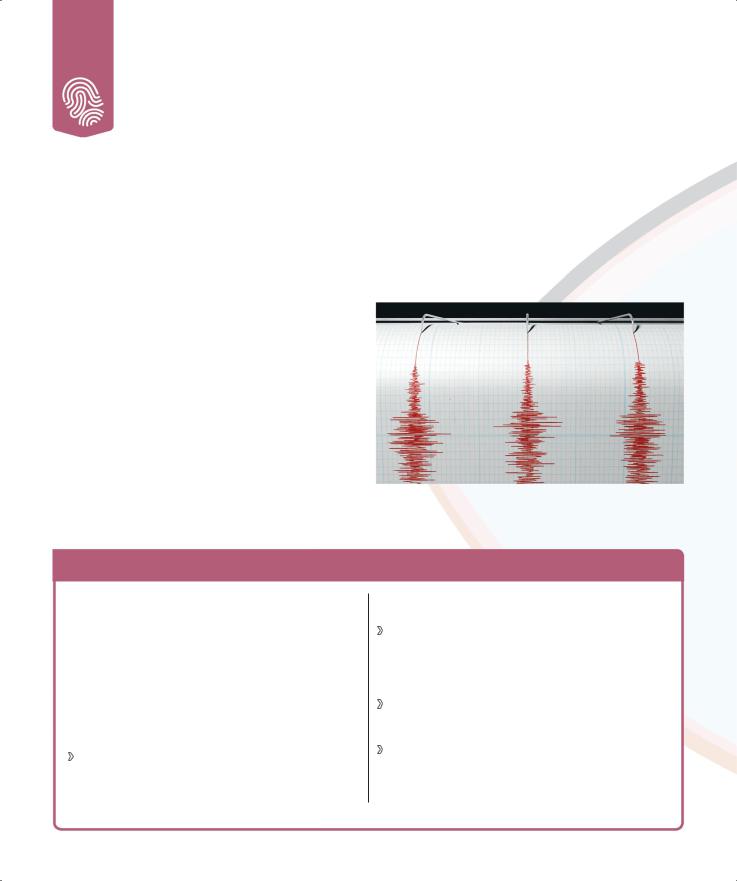
Psychology and criminal investigations
The process of investigating crimes and identifying offenders is often long and painstaking. Psychologists can help police during this process, chiefly in data analysis and victim and suspect interviews.
How are psychologists involved?
Books and films rarely depict the labor-intensive work involved in most criminal investigations. If there is no obvious suspect, detectives must review a vast amount of information from records of previous crimes or criminals to surveillance recordings; photographs of crime scenes; and interviews with victims, witnesses, and suspects. A forensic psychologist’s understanding of criminal behavior and the motivation behind it can be invaluable in collating and analyzing this material.
If a crime scene does not yield specific evidence, psychologists can create a profile from the forensic data that is collected, which may link a person or their behavior to the crime (p.198). Their knowledge of psychological disorders and the behavior patterns associated with them can also assist in the identification of suspects. They can use incisive interview techniques to ascertain as much as possible from a witness or suspect. A psychologist can also
use their understanding of human behavior and the fallibility of human memory to help ascertain whether a person is telling the truth or is covering for someone.
A LIE DETECTOR, OR POLYGRAPH, can detect an individual’s responses to questioning and can be effective in supporting the case of an innocent person.
COGNITIVE INTERVIEW TECHNIQUE
Interviews—whether of victims, eyewitnesses, or suspects— are central to criminal investigations and are an area where the expertise of a forensic psychologist is invaluable. The cognitive interview uses a specific method of questioning that in the hands of a skilled psychologist can actually help improve a person’s memory of an event. The person needs to feel safe, and the interviewer must be patient, pose the questions in the right way, and allow sufficient time for a response. Some people do not respond to this type of interview, in which case the investigators may need to try a different approach.
A safe environment for the witness is established to ensure a sense of mutual understanding. If the interviewer actively and attentively listens to what the interviewee is saying, even asking them about their general activities
and feelings that day, the interviewee will relax and trust the interviewer enough to talk freely.
Free-form recollection is encouraged by posing open-ended questions rather than ones that require yes/no answers. The interviewer must not interrupt
the interviewee’s response, and allow for plenty of breaks to give them the time to remember events more clearly.
A conducive context is created, for example by describing the background of the event(s) being recalled, which can strengthen an interviewee’s memory.
Patience is maintained throughout, especially if the interviewee is uncooperative. It is essential for an interviewer to keep frustration and feelings of coercion in check to avoid the interviewee making a false confession.
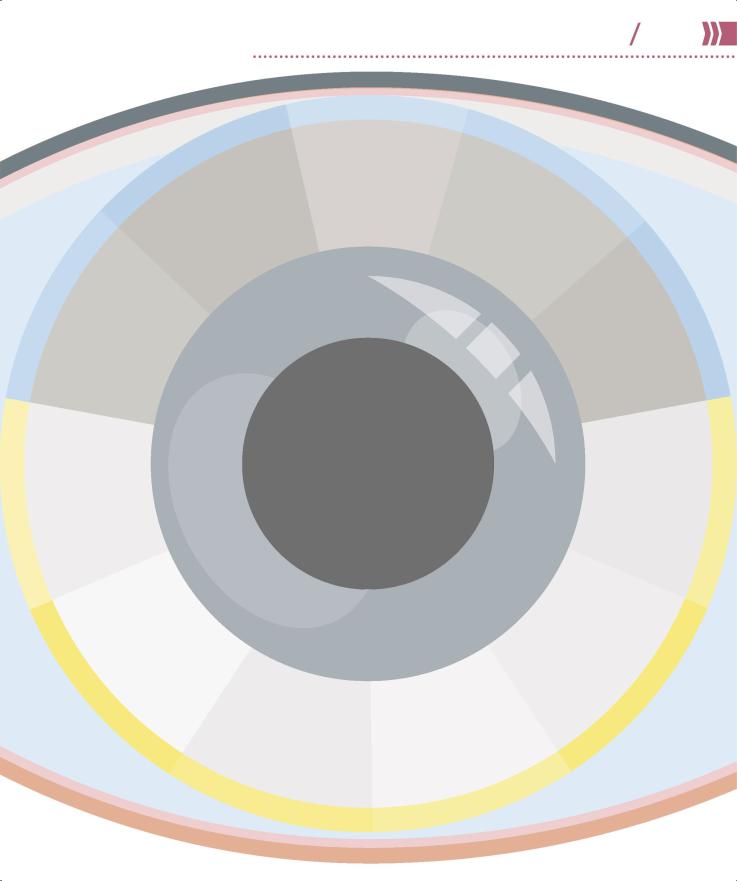
PSYCHOLOGY IN THE REAL WORLD |
196 197 |
Forensic psychology |
t A
|
e |
h |
|
t |
|
crime
sc
e
ne
|
DISTANCE FROM |
|
|
|
OFFENDER |
|
|
|
The greater the distance |
|
|
RACE, GENDER, |
between the witness and |
USE OF A WEAPON |
|
the suspect/event, the |
|||
AND AGE |
If a crime involves a |
||
If a witness is of a |
less accurate their |
knife or gun, witnesses |
|
memory will be. |
|||
different age, gender, |
often remember fewer |
||
|
|||
or race than the suspect, |
|
details as the weapon |
|
they are more inclined |
|
holds their focus. |
|
to misidentify them. |
|
|
|
OFFENDER’S |
|
STRESS LEVELS |
|
BEHAVIOR |
|
OF WITNESS |
|
Witnesses are more |
|
Experiencing a very |
|
likely to remember |
|
stressful crime alters |
|
distinctive aspects |
|
perceptions and |
|
of an offender’s |
|
memory, and can |
|
appearance, speech, |
|
lead to inaccurate |
|
or behavior. |
|
identifications. |
AGE OF WITNESS
Children, the frail, and the elderly are vulnerable to the pressure of being interviewed. Older children remember more details than
younger ones.
FACTORS AFFECTING EYEWITNESS MEMORY
Accounts from eyewitnesses play a key role in police investigations, and a number of factors—both at the crime scene and afterward— affect their accuracy. Erroneous
eyewitness evidence and/or identification have often led to false convictions.
FATIGUE OF
WITNESS
Tiredness affects memory. Allowing adequate rest before questioning protects memory from interference and enables more accurate recall.
RETENTION |
|
SUSCEPTIBILITY |
INTERVAL |
|
OF WITNESS |
If a police interview |
|
When viewing a lineup, |
takes place a long time |
|
law enforcement officers |
after an event, the |
|
can unintentionally |
witness will recall it in |
|
indicate to witnesses |
far less detail. |
|
who they should |
VIEWING A LINEUP |
PROVIDING LINEUP |
choose. |
Suspects are displayed |
INSTRUCTIONS |
|
in a group or one at |
Witnesses who are clearly |
|
a time. The latter requires |
informed that they do not |
|
the witness to compare |
have to choose a suspect |
|
the suspects with |
from a lineup are less |
|
their memory of the |
likely to make a false |
|
offender only. |
identification. |
|
D
u
r
i
n
g
q
|
|
|
|
g |
|
|
|
n |
|
|
|
i |
|
|
|
n |
|
|
|
io |
|
|
|
|
uest |
|
|
|
|
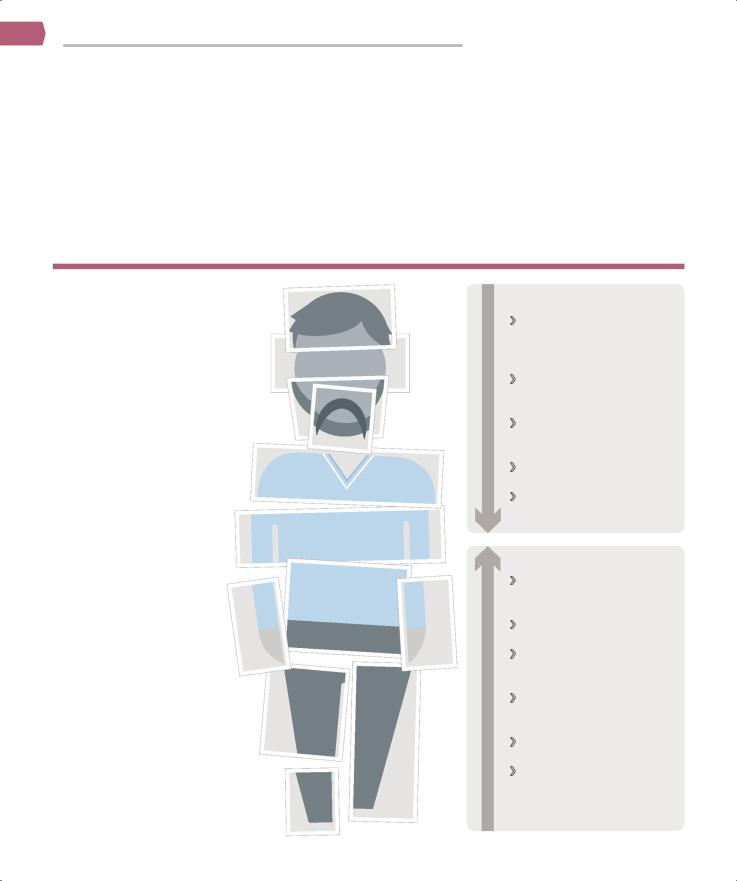
PSYCHOLOGY AND CRIMINAL INVESTIGATIONS
Is there a “criminal type”?
There is no specific set of attributes that conclusively determines criminal behavior, but some are more commonly associated with criminality. These include low intelligence, hyperactivity, difficulty concentrating, a poor education, antisocial behavior, having siblings or friends who are in trouble with the law, and habitual drug or alcohol abuse. In addition, males of any age are significantly more likely to offend than females—
especially when it comes to violent crimes. Those who have been convicted are more likely to have had a chaotic or disruptive childhood—but not all such upbringings lead to criminality.
Among the young, the cycle of negative behavior can often be broken by intervention with protective factors, such as positive relationships outside the family, academic achievement, positive attitudes toward authority, and effective use of leisure time.
Offender profiling
This is the process of using evidence and information from both the victim and the crime scene, as well as the characteristics of the crime, to form hypotheses about the type of person who might have committed it. Some crime scenes offer few significant clues, which forces detectives to make imaginative leaps. This is where the developing science of investigative psychology can be utilized. There are two ways of looking at profiling: the top-down method (used mainly in the US) and the bottom-up approach (used in the UK).
“Psychology often presents individuals as if they are frozen in time and space.”
Professor David Canter,
British psychologist
Top-down profiling
Aims to test reliability of organized/disorganized criminal behavior and motivation, or typologies.
Matches a general type of criminal to features of a particular crime.
Aims to detect signature aspects of the crime and patterns of the criminal.
Relies on the behaviorist perspective (pp.16–17).
Is best applied to crimes such as rape and murder.
Bottom-up profiling
Aims to identify a behavior pattern from similarities between offenses.
Is data-driven and based on clear psychological principles.
Uses forensic evidence and data to build patterns of behavior piece by piece.Produces measured, specific associations between crimes
and offenders.
Makes no initial assumptions about offenders.
Seeks consistencies in offender behavior, from both crime scene evidence and eyewitness accounts.
